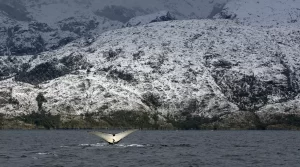Francisco Coloane Marine Park, located in Chilean Patagonia, is a haven for nature enthusiasts and adventure seekers. It is Chile’s first marine protected area, known for its dramatic landscapes, thriving marine life, and untouched wilderness. The park offers a unique opportunity to witness Patagonian fjords, glaciers, and diverse wildlife, including humpback whales and Magellanic penguins.
Essential Information
- Location: Western Patagonia, near the Strait of Magellan, approximately 80 km (50 miles) from Punta Arenas.
- Size: 67,197 hectares (165,980 acres), encompassing marine and coastal ecosystems.
- Climate: Cold and wet, with strong winds year-round. Summer (December to February) is the most temperate season for visiting.
- Best Time to Visit: November to April, when wildlife is abundant, and weather conditions are favorable.
- Entry Requirements: Most tours include park access fees. No independent travel is allowed within the park; visits are organized through guided tours.
Interesting Facts About Francisco Coloane Marine Park
- Named after Chilean author Francisco Coloane, who wrote extensively about Patagonia.
- It is one of the few places in the world where humpback whales feed close to the shore.
- The park is home to glaciers from the Southern Patagonian Ice Field, one of the largest freshwater reserves on Earth.
- Besides marine life, it features dense sub-Antarctic forests, rocky cliffs, and pristine waterways.
- It’s a crucial breeding and feeding ground for several species, including sea lions, dolphins, and penguins.
How to Get There
- Fly to Punta Arenas:
- The nearest city with an airport is Punta Arenas, served by domestic flights from Santiago and Puerto Montt.
- Join a Guided Tour:
- Access to the park is typically arranged via guided boat tours departing from Punta Arenas.
- Cruise Ships:
- Some Patagonian cruises include stops at Francisco Coloane Marine Park as part of their itinerary.
Best Things to Do
- Whale Watching:
- Spot majestic humpback whales feeding in the park’s nutrient-rich waters.
- Glacier Exploration:
- Marvel at glaciers like Santa Inés and Isla Carlos III, with opportunities for kayaking near the icy giants.
- Wildlife Spotting:
- Observe colonies of sea lions, Magellanic penguins, and various seabird species, including albatrosses.
- Fjord Navigation:
- Cruise through stunning fjords surrounded by snow-capped peaks and dense forests.
- Kayaking Adventures:
- Paddle through the tranquil waters for an intimate experience with the park’s serene landscapes.
- Photography:
- Capture dramatic vistas and incredible wildlife moments.
Best Accommodation Options
- Punta Arenas (Base City):
- Hotel Cabo de Hornos: A luxurious hotel offering modern amenities and panoramic views of the Strait of Magellan.
- Hotel Ilaia: Known for its eco-friendly design and excellent service.
- Hostel Keoken Patagonia: A cozy, budget-friendly option with a welcoming atmosphere.
- Isla Carlos III:
- EcoCamp Carlos III: A unique lodge offering comfortable dome accommodations and guided tours within the park.
Good Attractions
- Santa Inés Glacier:
- A stunning glacier accessible by boat or kayak, showcasing the region’s icy beauty.
- Isla Carlos III:
- The base for many eco-lodges and whale-watching expeditions.
- Alacalufes National Reserve:
- Adjacent to the marine park, this reserve features lush forests and unique flora.
- Strait of Magellan:
- The iconic waterway connecting the Atlantic and Pacific Oceans, rich in history and biodiversity.
Getting Around
- Boat Tours:
- Essential for exploring the marine park, as the region is primarily accessible by water.
- Kayaks:
- Available through guided excursions, allowing a closer interaction with the park’s environment.
- Cruise Ships:
- Some luxury cruises include multi-day itineraries that cover the park and surrounding areas.
Day Trips
- Penguin Colonies at Isla Magdalena:
- A short boat ride from Punta Arenas to see thousands of Magellanic penguins.
- Torres del Paine National Park:
- A full-day excursion to one of Patagonia’s most iconic parks, offering dramatic mountain landscapes.
- Puerto del Hambre (Port Famine):
- A historical site near Punta Arenas with scenic views and a glimpse into the region’s past.
Practical Tips
- Dress Warmly:
- Layers, waterproof clothing, and sturdy boots are essential for staying comfortable in the cold, wet conditions.
- Book Early:
- Tours fill up quickly during peak season, so reserve your spot well in advance.
- Wildlife Respect:
- Maintain a safe distance from animals and follow your guide’s instructions to protect the park’s ecosystem.
- Camera Gear:
- Bring waterproof cases and extra batteries to capture the park’s breathtaking scenery.
- Travel Insurance:
- Ensure your policy covers adventure activities and potential weather-related delays.
Conclusion
Francisco Coloane Marine Park is a spectacular showcase of Chilean Patagonia’s natural wonders. From close encounters with humpback whales to serene moments among fjords and glaciers, the park offers an unforgettable blend of adventure and tranquility. Whether you’re navigating its icy waters or marveling at its abundant wildlife, a visit to this remote paradise is sure to leave a lasting impression.
Plan your trip to Francisco Coloane Marine Park and experience the awe-inspiring beauty of Patagonia!

